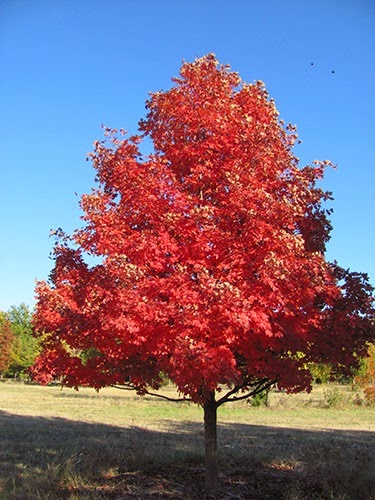Growing Tomatoes 101
Cassie Homan, Horticulture Agent
 Tomatoes are one of the most common veggies grown in the garden and for good reason, nothing beats the taste of a juicy tomato on a hot summer day. Store-bought tomatoes just can’t compare with a fresh, ripe tomato picked straight from the garden. They are easy to grow and you don’t need to plant many to have a bountiful harvest. Here are some tips to have a successful tomato crop this year.
Tomatoes are one of the most common veggies grown in the garden and for good reason, nothing beats the taste of a juicy tomato on a hot summer day. Store-bought tomatoes just can’t compare with a fresh, ripe tomato picked straight from the garden. They are easy to grow and you don’t need to plant many to have a bountiful harvest. Here are some tips to have a successful tomato crop this year.
When to Plant
Plant tomatoes after all danger of frost is past. For North Central Kansas early May is a good time to starting thinking about getting your plants in the ground, although this year may be a little later than normal. Wait until soil is about 60F degrees before planting.
Spacing
Most garden tomatoes should be spaced at least 18 inches apart to 2 feet apart in rows 3-5 feet apart. Newer varieties called dwarf tomatoes can be spaced closer, or planted in containers.
Care
 Tomatoes are usually grown from transplants. Choose a strong healthy transplant that has a dark green color and balance between the size of the plant and the container. Set the plant slightly deeper than the container and firm soil well around the root system. Water with a starter solution immediately after planting. Tomatoes respond to mulching because they require stable soil moisture. Black plastic mulch encourages early growth, while organic mulches are excellent for summer when applied 2-3 weeks after planting. Weeds compete with tomatoes for nutrients, water, and light. Use shallow cultivation near the plants to scrape away small weeds. A side-dressing of fertilizer when the first fruits on the plant are about the size of a walnut usually will improve yields and lengthen the harvest period. Cold nights early in the growth period or hot, dry, windy weather may cause blossom damage or blossom drop.
Tomatoes are usually grown from transplants. Choose a strong healthy transplant that has a dark green color and balance between the size of the plant and the container. Set the plant slightly deeper than the container and firm soil well around the root system. Water with a starter solution immediately after planting. Tomatoes respond to mulching because they require stable soil moisture. Black plastic mulch encourages early growth, while organic mulches are excellent for summer when applied 2-3 weeks after planting. Weeds compete with tomatoes for nutrients, water, and light. Use shallow cultivation near the plants to scrape away small weeds. A side-dressing of fertilizer when the first fruits on the plant are about the size of a walnut usually will improve yields and lengthen the harvest period. Cold nights early in the growth period or hot, dry, windy weather may cause blossom damage or blossom drop.
Harvesting
 Tomatoes will ripen on or off the plant when the fruit are full sized and starting to show a slight tinge of color. Harvest early to reduce the chances of cracking, fruit rots, and other damage. Early harvest encourages additional production. Store ripening fruit at 55F degrees for maximum storage life or place them in a warmer location for quicker ripening. Red pigments do not form in temperatures of 95F degrees or above; therefore, deeper red color will result from ripening off the vine in summer heat.
Tomatoes will ripen on or off the plant when the fruit are full sized and starting to show a slight tinge of color. Harvest early to reduce the chances of cracking, fruit rots, and other damage. Early harvest encourages additional production. Store ripening fruit at 55F degrees for maximum storage life or place them in a warmer location for quicker ripening. Red pigments do not form in temperatures of 95F degrees or above; therefore, deeper red color will result from ripening off the vine in summer heat.
If you’ve never planted tomatoes before, this is your year to get some started! They are easy to grow and you will be rewarded with juicy fruit throughout the season. For further information on tomato gardening, contact Cassie at any Post Rock Extension District Office in Beloit, Lincoln, Mankato, Osborne or Smith Center, or email choman@ksu.edu
If you would like to know what tomato varieties will thrive in our Kansas climate, go to https://www.bookstore.ksre.ksu.edu/pubs/L41.pdf
 Tomatoes are one of the most common veggies grown in the garden and for good reason, nothing beats the taste of a juicy tomato on a hot summer day. Store-bought tomatoes just can’t compare with a fresh, ripe tomato picked straight from the garden. They are easy to grow and you don’t need to plant many to have a bountiful harvest. Here are some tips to have a successful tomato crop this year.
Tomatoes are one of the most common veggies grown in the garden and for good reason, nothing beats the taste of a juicy tomato on a hot summer day. Store-bought tomatoes just can’t compare with a fresh, ripe tomato picked straight from the garden. They are easy to grow and you don’t need to plant many to have a bountiful harvest. Here are some tips to have a successful tomato crop this year. When to Plant
Plant tomatoes after all danger of frost is past. For North Central Kansas early May is a good time to starting thinking about getting your plants in the ground, although this year may be a little later than normal. Wait until soil is about 60F degrees before planting.
Spacing
Most garden tomatoes should be spaced at least 18 inches apart to 2 feet apart in rows 3-5 feet apart. Newer varieties called dwarf tomatoes can be spaced closer, or planted in containers.
Care
 Tomatoes are usually grown from transplants. Choose a strong healthy transplant that has a dark green color and balance between the size of the plant and the container. Set the plant slightly deeper than the container and firm soil well around the root system. Water with a starter solution immediately after planting. Tomatoes respond to mulching because they require stable soil moisture. Black plastic mulch encourages early growth, while organic mulches are excellent for summer when applied 2-3 weeks after planting. Weeds compete with tomatoes for nutrients, water, and light. Use shallow cultivation near the plants to scrape away small weeds. A side-dressing of fertilizer when the first fruits on the plant are about the size of a walnut usually will improve yields and lengthen the harvest period. Cold nights early in the growth period or hot, dry, windy weather may cause blossom damage or blossom drop.
Tomatoes are usually grown from transplants. Choose a strong healthy transplant that has a dark green color and balance between the size of the plant and the container. Set the plant slightly deeper than the container and firm soil well around the root system. Water with a starter solution immediately after planting. Tomatoes respond to mulching because they require stable soil moisture. Black plastic mulch encourages early growth, while organic mulches are excellent for summer when applied 2-3 weeks after planting. Weeds compete with tomatoes for nutrients, water, and light. Use shallow cultivation near the plants to scrape away small weeds. A side-dressing of fertilizer when the first fruits on the plant are about the size of a walnut usually will improve yields and lengthen the harvest period. Cold nights early in the growth period or hot, dry, windy weather may cause blossom damage or blossom drop. Harvesting
 Tomatoes will ripen on or off the plant when the fruit are full sized and starting to show a slight tinge of color. Harvest early to reduce the chances of cracking, fruit rots, and other damage. Early harvest encourages additional production. Store ripening fruit at 55F degrees for maximum storage life or place them in a warmer location for quicker ripening. Red pigments do not form in temperatures of 95F degrees or above; therefore, deeper red color will result from ripening off the vine in summer heat.
Tomatoes will ripen on or off the plant when the fruit are full sized and starting to show a slight tinge of color. Harvest early to reduce the chances of cracking, fruit rots, and other damage. Early harvest encourages additional production. Store ripening fruit at 55F degrees for maximum storage life or place them in a warmer location for quicker ripening. Red pigments do not form in temperatures of 95F degrees or above; therefore, deeper red color will result from ripening off the vine in summer heat.If you’ve never planted tomatoes before, this is your year to get some started! They are easy to grow and you will be rewarded with juicy fruit throughout the season. For further information on tomato gardening, contact Cassie at any Post Rock Extension District Office in Beloit, Lincoln, Mankato, Osborne or Smith Center, or email choman@ksu.edu
If you would like to know what tomato varieties will thrive in our Kansas climate, go to https://www.bookstore.ksre.ksu.edu/pubs/L41.pdf






